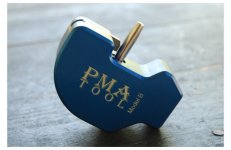Hi,
First time neck turner here. I'm using the K&M Neck Turning tool with 6.5 Creedmoor Lapua cases (LR primers).
I started with a big mistake: didn't lube enough and a ring of brass formed on the pilot (see on the picture below):

This caused deep scratches/grooves to form INSIDE the necks of the cases (I did 50 before noticing it...). On the video below you can see and hear the scratches:
I put the pilot in copper remover for a few hours and the golden ring completely disappeared.
I thought I fixed the issue for good, but now, even when using lots of lube (Redding Imperial Sizing Die Wax), there are light scratches (this time not deep, you can't/can barely feel them) but still, there are scratches...
Is this "normal" or should the inside of the neck be 100% free of any scratches? Did you ever experience this issue? What lube do you use to turn necks?
First time neck turner here. I'm using the K&M Neck Turning tool with 6.5 Creedmoor Lapua cases (LR primers).
I started with a big mistake: didn't lube enough and a ring of brass formed on the pilot (see on the picture below):
This caused deep scratches/grooves to form INSIDE the necks of the cases (I did 50 before noticing it...). On the video below you can see and hear the scratches:
I put the pilot in copper remover for a few hours and the golden ring completely disappeared.
I thought I fixed the issue for good, but now, even when using lots of lube (Redding Imperial Sizing Die Wax), there are light scratches (this time not deep, you can't/can barely feel them) but still, there are scratches...
Is this "normal" or should the inside of the neck be 100% free of any scratches? Did you ever experience this issue? What lube do you use to turn necks?


